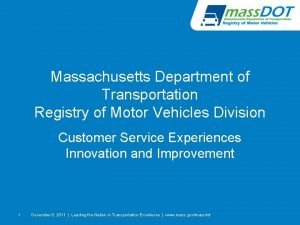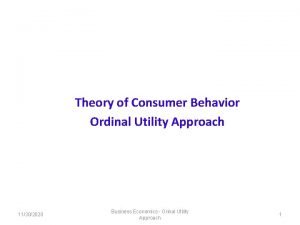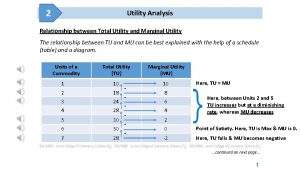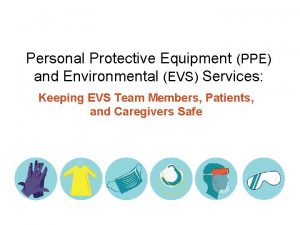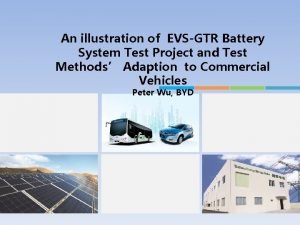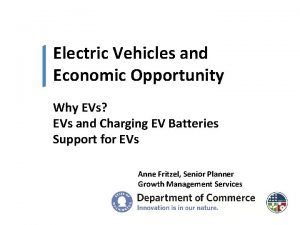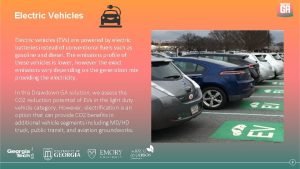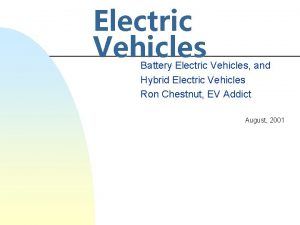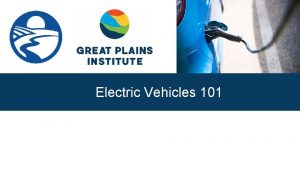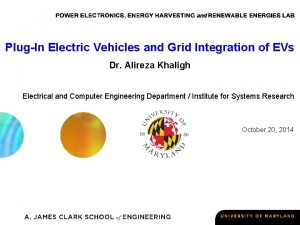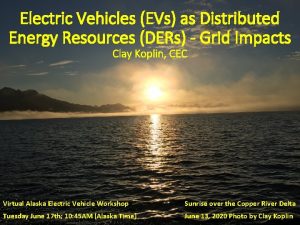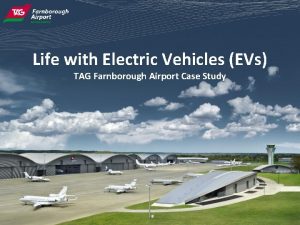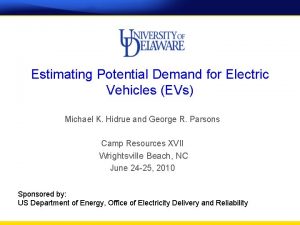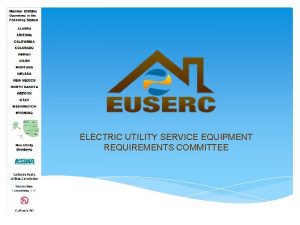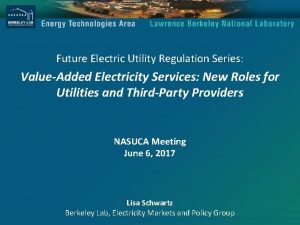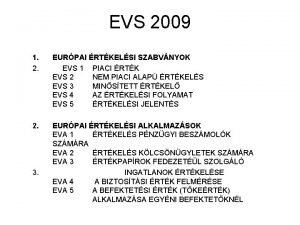Electric Utility Department Why now Electric vehicles EVs














- Slides: 14

Electric Utility Department

Why now? § Electric vehicles (EVs) have been around for over 100 years, but they haven’t been popular until now. Why? § Outside of the high gas prices, pollution reduction and government mandates, EVs have recently added several benefits…

EV basic terms EV/PEV - Electric Vehicle/Plug-in Electric Vehicle BEV - Battery Electric Vehicle (Battery Only) PHEV - Plug-in Hybrid Electric Vehicle (gas and BEV) k. Wh Capacity - Kilowatt hour (EV battery capacity, about 3. 3 miles/k. Wh) k. Wh Usage - How your monthly electricity usage is measured EVSE - Electric Vehicle Supply Equipment (delivers electricity to the EV) Charger - Level 1, Level 2, DC Fast Charger Connector - J 1772 (L 1 & L 2 connector) CHAde. MO (Fast charger connector)

Battery Electric Vehicles

How they work § Small number of main components § Electric Motor § Large Battery § Charger § Electronics § No oil (no oil changes) § Regenerative braking (less brake wear) § Few moving parts (few mechanical problems) § Less heat generated (parts last longer) § Lower overall maintenance saves you $$

Will it get me where I want to go? Average driver in CA drives 40 miles per day § BEV-all electric § § PHEV-electric motor and gas engine § § EV range up to 93 miles (up to 620 miles total range) Price Range § § Several models in mid 200 mile range (some 300+ miles) After incentives, around $20 k-$180 K Battery range depends on many factors § Temperature, habits, terrain, etc.

How does charging work? § The EV has a charger built in, the EVSE connects the electricity to the charger, regulates flow, communicates with the EV § Home charging § Level 1 - 120 volt standard outlet (overnight fills up 30 miles) § Level 2 - 240 volt outlet (the same as electric dryers) § Charges at least twice as fast and can be much faster § Level two is typical for home and public charging § $600 plus installation

DC Fast Charging • High powered public charging • Mostly near shopping centers and hotels • Easy and safe • High commercial grade voltage • Will charge many EVs to 80% in 20 to 30 minutes • Not for all EVs

Where do I charge my EV? § Your “gas station” is your garage § Odorless fuel at home without waiting in line or searching for a gas station. § You plug in at night and wake up with a full “tank” every morning. For less than $1 per “gallon” § Public L 2 ~ $2/gallon

Is gas or electricity cheaper? § The average daily drive is 40 miles, normally less on weekends. § 12, 000 miles per year = about 33 miles per day § 33 miles per day (about 300 k. Whs) = $28 to $43 per month based on Roseville Electric rates § Driving a normal gas fueled car 33 miles per day (assuming 25 miles per gallon @ $3. 50 per gallon) = $140 per month in gas Savings of up to $112 per month

Are there environmental benefits? • Gas powered vehicles emit smog, soot and other air pollution, which can lead to serious impacts on health and the environment. • The average EV reduces greenhouse gas emissions by approximately 2 metric tons per year. • With the increasing number of renewables on the electric grid, the emissions reductions will continue to increase.

What incentives are available? § Federal Tax credit up to $7, 500 on new EVs § California Clean Vehicle Rebate Project (CVRP) Rebate up to $2, 500 on new EVs § May depend on vehicle model and income § Roseville Electric Rebates § $300 for a new EV § $500 for a networked charger § Up to $1, 800 in incentives § Caution incentives may change

Finding the right EV for you • Our new online tool helps make electric vehicle shopping easy. • Plug. Star helps you find the EV that best meets your needs and gets you connected with a qualified EV dealer near you. • Visit our EV website for more information on: • Residential EV programs • Commercial EV programs • Our EV Ambassador program • Charging Stations

Questions? Rachel Radell-Harris EV Program Manager RAradell-harris@roseville. ca. us
 Massachusetts department of motor vehicles
Massachusetts department of motor vehicles Pictures
Pictures Ordinal and cardinal utility
Ordinal and cardinal utility Relation between marginal utility and total utility
Relation between marginal utility and total utility The mvc will monitor a new driver’s habits for how long?
The mvc will monitor a new driver’s habits for how long? Now i see it now you don't
Now i see it now you don't Dont ask
Dont ask What is community eating
What is community eating Animals whose ears can be seen
Animals whose ears can be seen Evs protection
Evs protection It's raining evs class 3
It's raining evs class 3 Transactional strategy instruction
Transactional strategy instruction Food and fun ppt
Food and fun ppt C tech software
C tech software Evs-gtr
Evs-gtr
